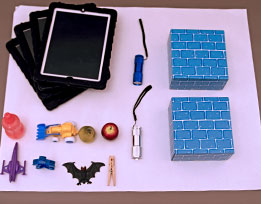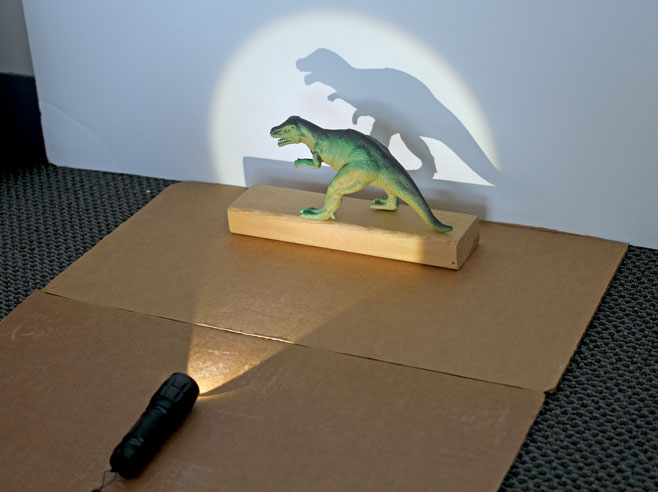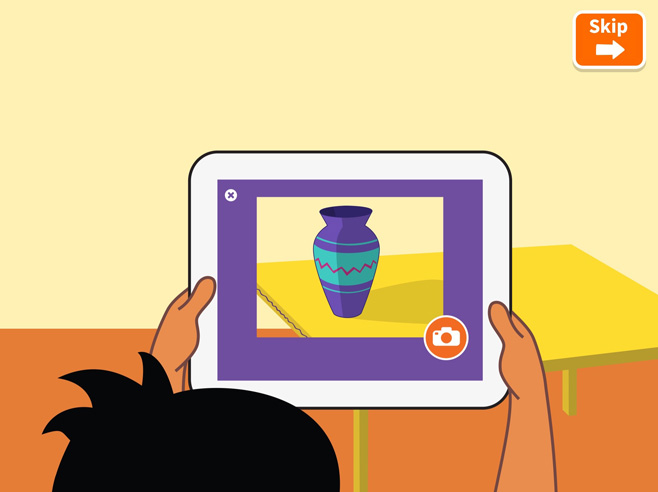Inspired by photos in the book Guess Whose Shadow?, children stage and photograph their own mystery shadows, creating a digital guessing game to share with their classmates.
Materials

- Blocks (a few to create a stage for the props)
- Mystery Shadows tool in the digital Shadows Journal on 4 iPads (a different iPad for each group of children)
- 1–2 LED flashlights
- Projector (if available)
- 8–12 classroom or kitchen objects (props) that can make interesting combined shadows
- 2 smaller white tri-fold display boards to use as a “shadow wall”
- Guess Whose Shadow? book by Stephen R. Swinburne
Preparation
- Familiarize yourself with the Mystery Shadows tool in the digital Shadows Journal.
- Prepare an iPad for each small group of children. This ensures that at the Digital Learning Center, each iPad will have a collection of Mystery Shadows photos for children to enjoy.
- If using, set up a projector to display the iPads.
- Gather the sets of props for each lesson.
- Set up a Mystery Shadows stage in a darkened part of the room where you will meet for Guided Small Group sessions, as seen in the slideshow. Check that the objects’ shadows appear on the white shadow wall when they are placed on one or more blocks (the “stage”) and are lit by a flashlight from slightly below.
- Prior to Lesson 7, try making some combined shadows yourself! An ice cube tray, a pencil holder with several compartments, and the bottom half of an egg carton are examples of objects that can help support other props.
- For Lesson 7, set up two Shadow Stations, each with a flashlight aimed at a white shadow wall. The flashlight should be about 3 feet away from the shadow wall. You may want to place a piece of colored paper 6–12 inches away from the shadow wall as a guide to where children will build the “stage” that will support their prop structures.
- Take a few Mystery Shadows photo pairs using this setup so you will be aware of any challenges and can be prepared with solutions.
Directions: Lesson 2
Guided Small Group
- Let children take turns placing an object of their choice on the shadow stage to cast a shadow on the shadow wall surface. Engage children in science talk about shadows and how they are made. Possible discussion ideas:
- Point to the shadow. Why are we seeing a shadow on this surface?
- What do you need to make a shadow?
- If we turned off the flashlight, what do you predict would happen to the shadow? Why do you think that? Try it out! Are the children’s predictions correct?
- Remind children of the guessing game in the book Guess Whose Shadow? The “guessing game” photos in the second half of the book, along with the text below the photos, serve as inspiration for the digital Mystery Shadows game that children will create. Share those photos with the children; turn the page to see if the children’s guesses are correct.
- Tell children that they will be taking similar photos of mystery shadows for their classmates to guess. Have children choose a favorite object to put on the shadow stage.
- Open the Mystery Shadows tool in the digital Shadows Journal. In the app, Nico provides step-by-step instructions on how to take photos for a Mystery Shadows game. Help children follow the instructions.
- It may be useful for two children to work together in taking a photo, one to steady the iPad and the other to tap the button. Children may need your help in positioning the iPad above and to the side of the shadow stage in order to frame and capture just the shadow.
- Each group should photograph at least two pairs of Mystery Shadows photos.
- Provide a different set of small toys or objects for the next small group to photograph—or allow children to gather their own set of small objects.
The photo pairs created during these activities will be used later in a whole-class Circle Time: Wrap-Up Mystery Shadows Game, in which children try to identify what made the shadows in photos taken by other children.
Directions: Lesson 7
Guided Small Group
- Display one prop on the “stage” of a Shadow Station and examine its shadow. What are some ways you can change this shadow by adding another shadow to it?
- Remind children that in Shadow Play Level 6, two objects that were not touching—a chair and a wheel—made a combined shadow. Let children experiment with placing a second object near the first one to see if they can make a combined shadow (as opposed to two separate shadows).
- Can children line up two props on the stage, one behind the other (not touching), so that they form a combined shadow?
- Can they stack the props on top of each other to make a combined shadow?
- Have children work in pairs or small groups to create a combined shadow.
- When the children have created a combined shadow they like, help them use the Mystery Shadows tool to photograph first the objects that are making the shadow, and then just the shadow. Encourage them to listen to Nico, the character in the app, as he provides step-by-step instructions.
- Provide children with support as needed. In particular, children may need your help in positioning the iPad above and to the side of the shadow stage in order to capture just the shadow in their photo.
The photo pairs created during these activities will be used later in a whole-class Circle Time: Wrap-Up Mystery Shadows Game, in which children try to identify what made the shadows in photos taken by other children.


